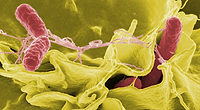FSIS Classifies Salmonella Newport as Reoccurring Strain

The U.S. Department of Agriculture’s Food Safety and Inspection Service (USDA’s FSIS) has published an after-action review (AAR) for two Salmonella Newport outbreaks that occurred during 2016–2019. Salmonella Newport has been characterized as a reoccurring strain because it has caused repeated outbreaks of human illnesses with similar epidemiologic characteristics. The investigations were conducted in collaboration with the U.S. Centers for Disease Control and Prevention (CDC).
For the two outbreaks covered by the AAR, the first had 106 recorded illnesses and the second had 436 recorded illnesses. The first outbreak occurred from October 4, 2016–July 19, 2017, and the second outbreak occurred from August 5, 2018–February 17, 2019. The age ranges were similar for the two outbreaks, with median ages of 44 and 42 for the first and second outbreaks, respectively. The outbreaks occurred across 36 states, and a majority of the reported ill people lived in the U.S. Southwest.
Of the 542 total recorded illnesses that occurred across 36 states, 163 hospitalizations and one death resulted. Specifically, 48 percent of case patients were hospitalized in the first outbreak, and 33 percent of case patients were hospitalized in the second outbreak.
Both outbreaks were associated with ground beef, which may have been undercooked. The AAR notes that it is unusual for such a high volume of cases to be linked to foodborne illness outbreaks that are caused by ground beef. At least 80 percent of the case patients had eaten ground beef a week prior to the onset of their illnesses, with a total of 40 case patients able to confirm their consumption of ground beef with documentation.
In the first outbreak, three cattle isolates were collected by public health partners. At least one ground beef sample tested positive for Salmonella Newport, which whole genome sequencing (WGS) found to be closely related to clinical isolates. In the second outbreak, seven isolates from ground beef matched the outbreak strain. The analyzed isolates did not show any predicted antimicrobial resistance (AMR).
Traceback investigations were conducted for both outbreaks, but only in the second outbreak was an establishment identified as the source of the contaminated ground beef. The establishment was linked to 79 percent of cases in the second outbreak. The first outbreak did not lead to recall, but the second outbreak led to a recall of over 17 million pounds of ground beef.
FSIS and CDC are considering new ways to educate consumers on undercooking ground beef and cross-contamination. FSIS will also continue to monitor strains causing reoccurring human illnesses. Since reoccurring stains may indicate an environmental or animal reservoir for a pathogen, a National Veterinary Accreditation Program training module, which will promote pre-harvest practices to reduce pathogens, is in development.
Looking for a reprint of this article?
From high-res PDFs to custom plaques, order your copy today!








